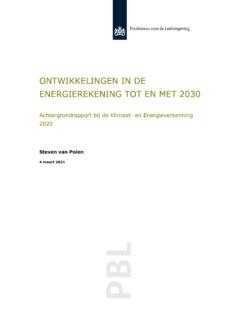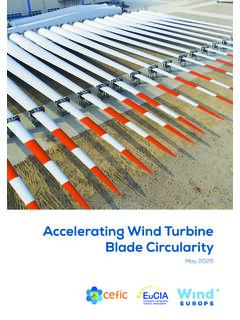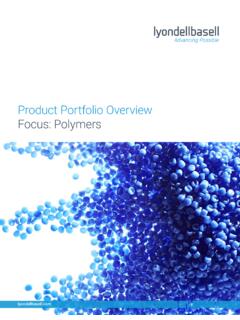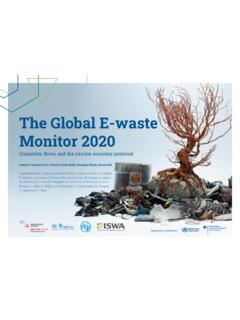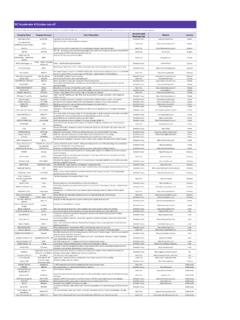Transcription of CIRCULAR ECONOMY: MEASURING INNOVATION IN THE …
1 CIRCULAR economy : MEASURING INNOVATION IN THE PRODUCT CHAIN Policy Report Jos Potting, Marko Hekkert, Ernst Worrell and Aldert Hanemaaijer January 2017 PBL | 2 CIRCULAR economy : MEASURING INNOVATION in the product chain English translation of the report Circulaire economie: Innovatie meten in de keten PBL netherlands Environmental Assessment Agency The Hague, 2017 PBL publication number: 2544 Corresponding author Authors Jos Potting1, Marko Hekkert2, Ernst Worrell2 and Aldert Hanemaaijer1 1 PBL netherlands Environmental Assessment Agency 2 Copernicus Institute of Sustainable Development, Utrecht University Acknowledgements Marc Pruijn and Tjeerd Meester (Ministry of Infrastructure and the Environment); Matthe s van de Pol (Ministry of Economic Affairs); Mandy Willems (Rijkswaterstaat); Jurgen Ganzevles, Frank Dietz, Ton Manders, Trudy Rood and Alexander van der Vooren (PBL); Dorith Vermunt, Deborah Kuppens and H meyra Izol (UU) Graphics PBL Beeldredactie Production coordination PBL Publishers Parts of this publication may be reproduced, providing the source is stated, in the form: Potting J, Hekkert M, Worrell E and Hanemaaijer A , (2016).
2 CIRCULAR economy : MEASURING INNOVATION in product chains. PBL netherlands Environmental Assessment Agency, The Hague. PBL netherlands Environmental Assessment Agency is the national institute for strategic policy analysis in the field of environment, nature and spatial planning. We contribute to improving the quality of political and administrative decision-making by conducting outlook studies, analyses and evaluations in which an integrated approach is considered paramount. Policy relevance is the prime concern in all our studies. We conduct solicited and unsolicited research that is both independent and scientifically sound. PBL | 3 Contents FINDINGS .. 4 FULL RESULTS .. 9 1 INTRODUCTION 9 About this study 11 Approach 11 Report structure 13 2 CONCEPTUAL FRAMEWORK 14 Goals for the transition towards a CIRCULAR economy 14 CE Transition and INNOVATION 16 MEASURING progress of CE transitions 19 3 CASES 23 Plastic packaging 23 Electrical and electronic equipment 27 CIRCULAR economy Green Deals 28 CIRCULAR economy Best Practices 33 4 DISCUSSION 37 CE transition and INNOVATION 37 CIRCULAR economy indicators 37 CE progress in the netherlands and internationally 39 Support for the CIRCULAR economy indicators 40 5 CONCLUSIONS 41 6 REFERENCES 42 PBL | 4 FINDINGS At the request of the Dutch Ministry of Infrastructure and the Environment, PBL netherlands Environmental Assessment Agency and Utrecht University have explored ways to measure progress of a transition towards a CIRCULAR economy in product chains.
3 This study focuses on identifying what needs to be measured, rather than how MEASURING should be carried out. We developed a conceptual framework about the role of INNOVATION in CIRCULAR economy transitions (CE transitions) in product chains, and applied it to a number of cases. The framework and case applications serve to determine what type of information is needed to measure the progress of CE transitions in product chains. The second Dutch coalition government under Prime Minister Mark Rutte aims to establish a CIRCULAR economy . The Dutch Ministry of Infrastructure and the Environment describes a CIRCULAR economy as an economic system based on the reusability of products and product components, recycling of materials, and on conservation of natural resources while pursuing the creation of added value in every link of the system. The government wants to promote the CE transition through better closing of product and material chains.
4 This study targets product chains. A product chain tracks products from the extraction of natural resources to waste treatment after they have been discarded. Recovering materials from a discarded product often requires large amounts of energy, and pollution and mixing of materials reduces their quality which means that very often recycled (secondary) materials cannot be applied again for the same type of product. Frequently, these materials do find an application in other products with lower quality requirements. Therefore, a material chain may be longer than a single product chain. In a CIRCULAR economy , the materials recycled from a discarded product ideally retain their original quality so that they can be applied again in a similar product. As a result, no additional natural resources are needed to produce materials, and discarded products no longer become waste. This ultimate circularity, in which a product chain is closed because the materials can be applied over and over again (Figure 1), is probably not feasible in practice.
5 It is, however, the ideal situation which CE transitions aspire to bring about. More circularity is better for the environment Several circularity strategies exist to reduce the consumption of natural resources and materials, and minimise the production of waste. They can be ordered for priority according to their levels of circularity (Figure 1). Smarter product manufacturing and use, for example by product sharing, are generally preferred over extending the lifetime of products, because this product being used for the same product function or more users being served by one product (strategy with high circularity). Lifetime extension is the next option and is followed by recycling of materials through recovery. Incineration from which energy is recovered has the lowest priority in a CIRCULAR economy , because it means the materials are no longer available to be applied in other products (low-circularity strategy).
6 As a rule of thumb, more circularity equals more environmental benefits. A higher level of circularity of materials in a product chain means that those materials remain in the chain for a longer period, and can be applied again after a product is discarded, preferably retaining their original quality. As a result, in principle, fewer natural resources are needed to produce new materials required for manufacturing products and for their subsequent use. Avoided resource extraction and production of materials benefit the environment. There are of course exceptions to this rule of thumb. For example, making a product chain more CIRCULAR may lead to increased natural resource consumption, usually in the form of (fossil) fuels. This occurs in chemical recycling of contaminated plastics which usually requires relatively large amounts of energy to decompose the material to its initial PBL | 5 building blocks, and then synthesise these building blocks back into material (back-to-monomer recycling).
7 Another example is intensifying product use, by facilitating access to the use of a product ( product sharing or multi-functional products), which may lead to unintended additional forms of use. Car-sharing may motivate people without cars to opt for driving in situations they formerly would not have. It is advisable to examine the possibilities of rebound or secondary effects, but generally speaking, more circularity in a product chain leads to reduced consumption of natural resources and materials, and consequently to fewer environmental effects brought about by that product chain, as well as in related product chains. Three types of INNOVATION in product chains CE transitions may need INNOVATION and socio-institutional change. INNOVATION can take place in technology, product design and revenue models. Socio-institutional change involves reviewing written and unwritten rules, customs and beliefs.
8 Three types of CE transitions may be distinguished with regard to the use of technology in product chains: 1. CE transitions in which the emergence of specific, radically new technology is central and shapes the transition. This means radical INNOVATION in core technology, the specific technology around which a product is centred. Socio-institutional change is needed to PBL | 6 give the new technology a place in society. A typical example is the recent emergence of bioplastic which has already secured its place. 2. CE transitions in which socio-institutional change is central and where technological INNOVATION plays a secondary role (incremental INNOVATION in core technology). A good, perhaps somewhat extreme example is that of packaging-free shops. 3. CE transitions in which socio-institutional change is central, but are facilitated by enabling technology. An example is the transition to what has become known as the sharing economy .
9 This transition from owning a product to purchasing its services primarily involves socio-institutional change, but this is not possible without information technology to link service providers and users. There is a major difference between the type 3 transition on the one hand, and types 1 and 2 on the other. In contrast to types 1 and 2, achieving a type 3 transitions needs enabling technology of a generic character, such as information technology, or new materials. Type 3 transitions are promoted by technology development in other areas of knowledge than those specific to a given product chain. When monitoring progress towards a CIRCULAR economy , it matters which type of CE transition is envisaged and what roles are being played by socio-institutional change and INNOVATION . Besides INNOVATION in technology supporting the three types of CE transitions, this report also looks at INNOVATION in product design and revenue models.
10 Radical technological INNOVATION not always needed for CE transitions This report evaluates a large number of cases in which CE transitions in product chains are central. For each case, the study establishes the circularity strategies, the role of socio-institutional change (changes in written and unwritten rules, customs and beliefs) and the role of INNOVATION in technology, product design and revenue model. The evaluations show that radical technological INNOVATION is mainly of interest for recycling. In most cases, this involves adapting an existing recycling technique to the specific quality requirements of the product in question, following a process of incremental technological INNOVATION . Such adaptations may demand substantial efforts from the companies involved, but they can be made by using existing technological knowledge. When the focus is on radically new technology, the situation for CE transitions is rather different, because radical innovations emerge from a fundamentally new knowledge base and lead to a substantially different product.



